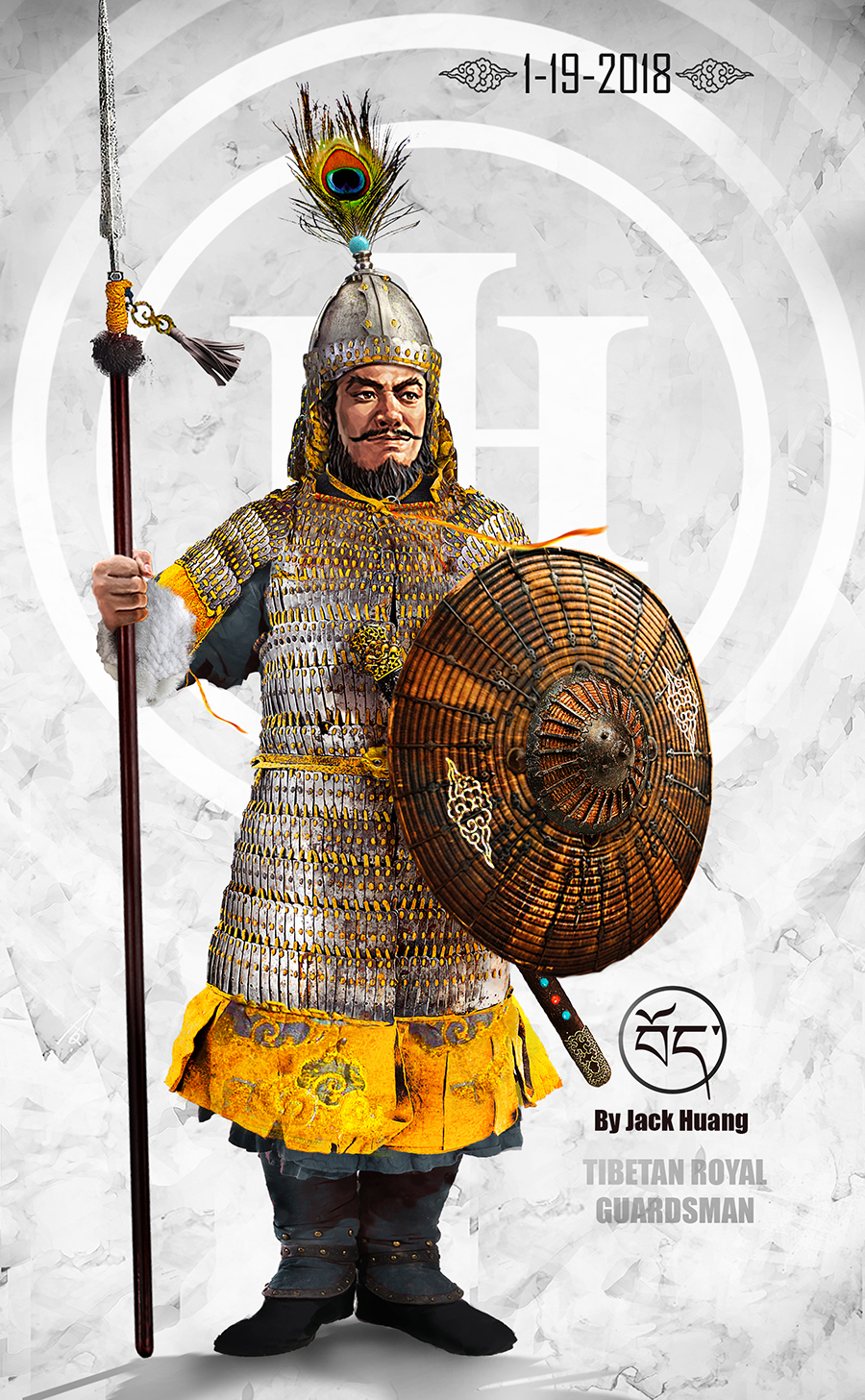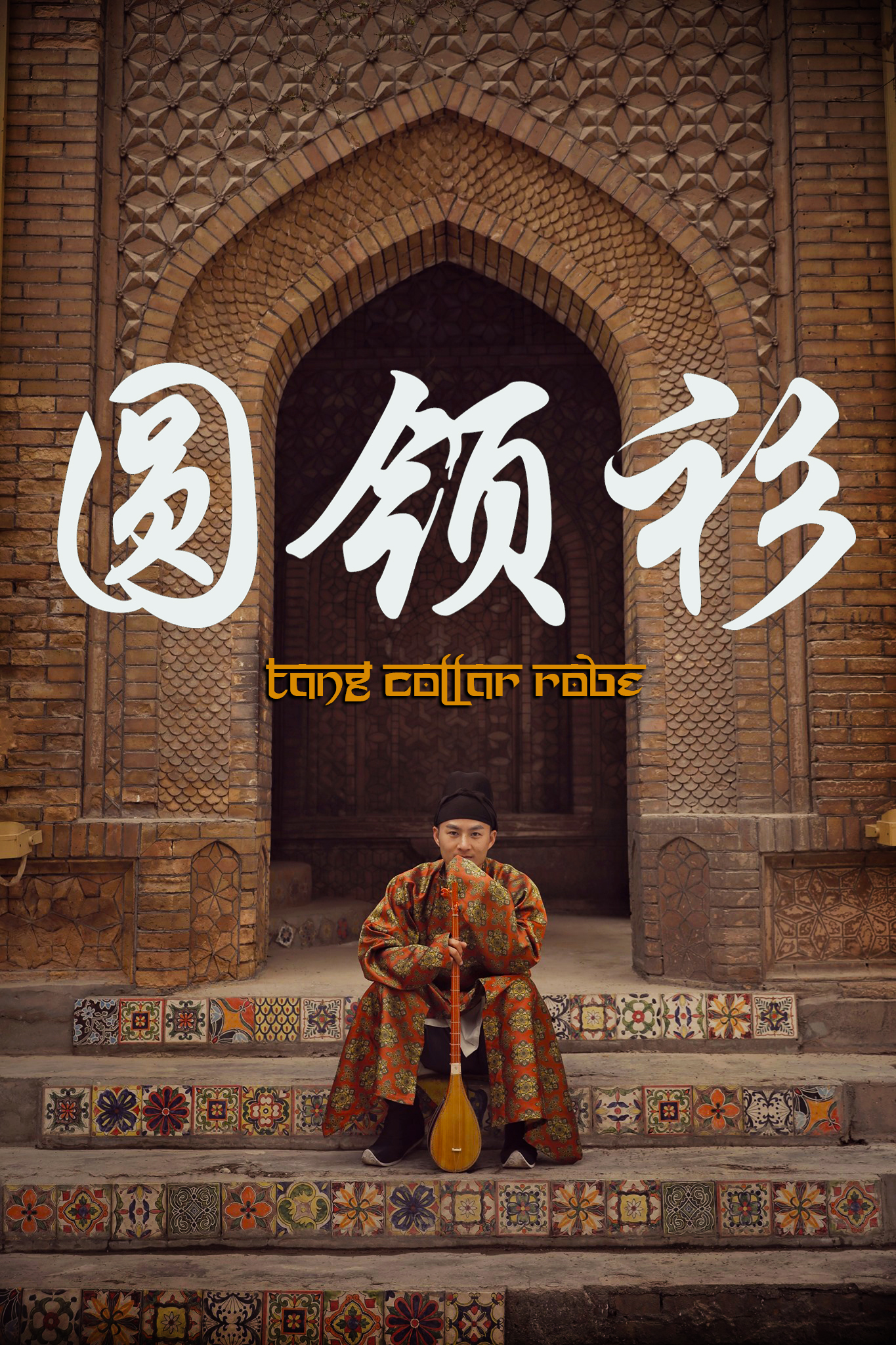Tibetan Royal Guardsman རོཡལ་ 吐蕃禁兵
Carrying long spears (mdung) these professional warriors (zimchongpa) wear mail armour constructed of either finely made iron rings or scales (lung gi khrab) or lamellae armor made of thin plates and iron foils (byang bu’i khrab). These infantrymen wear a short form of this armour (khrab thung ha) which covers the torso down to the knee.
In addition to their long spears (mdung) they carry distinctive rattan or cane shields (sba phub).
A BRIEF HISTORY OF THE TIBETAN EMPIRE
Though the Tibetan Empire and Tang Dynasty of China began as cautious friends and occasional adversaries, during the 8th and 9th century, the two polities became mortal rivals over the control of the Tarim Basin and all the lands east of the Gansu Corridor, sensing Tang weakness in the aftermath of the devastating An Lushan Rebellion where nearly 13~ 36 million of its subjects died, the resurgent Tibetan Empire under the able rule of their God- Emperor (Chosgyal) Trisong Detsen, would frequently launch deep and organized raids across the western frontiers of the Tang.
Padmasambhava Statue from the Johkan Temple, first built in the 7th century. Under strong Tibetan Emperors (Chosgyal) such as Songtsen Gampo, Trisong Detsen, and Ralpacan, Tibet became a supreme regional power by the advent of 7-9th century. Just like the Gokturks from the earlier part of Tang history, the Tibetan Empire would become one of the mortal nemesis of the Tang Empire during the latter part of its existence. However, it would suddenly implode in 842 when its last Emperor was assassinated by a Buddhist fanatic. Throughout the 800s, the Tang would frequently ally with the Uighur Kaganate against the Tibetan armies.
(Tibetan Empire in black, Tang in gold, and An Lushan's forces "Yan" in orange) The Massive An Lushan Rebellion effectively severed Tang China in half, leaving only a renegade court and several loyalist provinces that resisted the rebels.
During this time, the Tang Tarim Basin (left- yellow) holdings, called the Anxi Protectorate was completely stranded and lost all connection to the heartland of China because its only access to interior- the thin Ganxu Corridor was completely bottled up by the rebels. Seeing an opportunity to take all of the Tarim Basins, the Tibetans launched several invasions to take hold of the stranded province.
A Tang and Tibetan guard of the 8th century.
The fruits of their conquest would also be their downfall. For because they have risen so suddenly, and so successfully extended across so many domains, nearly all of their neighbors began to fear them- as one. The Tang and the Abbasid Caliphate were initially slow- to trust neighbors due to their first contact battle at the Talas River half a century earlier. But because of the unchecked strings of Tibetan expansions- until all the lands that lay between the Tang and the Abbasids all belonged to Tibet. The Abbasids, under their great Caliph Harun Al- Rashid struck an alliance with the Tang to check the Tibetan expansion. The webs of diplomacy would eventually be the undoing of the Tibetan Empire. Soon- the Uyghur Khaganate- allies of the Tang would also deal blows against Tibetan holds in the west.
THE FALL
Emperor Rapalcan, who once held sway over a vast domain over many kingdoms
However his reign was cut short.
With the death of Rapalcan and Langdarma, the Tibetan Empire would for centuries hence be shattered into hundreds of fiefs and fortified monasteries in an age called "The Era of Fragmentation." And with the death of the Tibetan Empire and Tang Dynasty China, both people looked toward different destinies. Tibet would remain fragmented for centuries to come while the Han Chinese would fragment into many warlordoms for nearly a century and then unite under a scholarly Song dynasty, of course by that time, the two people began their relations anew and engage in the trade of tea and horses. When the Song was threatened by steppe barbarian hordes from the north, the various Tibetans would sent aids of war horses while the Chinese traded them with gold and tea. The two people were both united for the first time under one government under the yoke of Kublai Khan's Mongol Yuan dynasty.
ARMOR
Tibetan armor was heavily influenced by the armors of China and the various Mongol peoples. According to Donald J. La Rocca of the Metropolitan Museum of Art's Department of Arms and Armor, Tibetan soldiers were most commonly protected by body armor, a helmet, and a rattan-reed shield reinforced with iron struts. Tibetan cavalry also protected their horses's bodies with thin leather armor and their heads with thick iron plates.
The most common form of Tibetan armor was lamellar armor called byang bu'i khrab, which was created by overlapping squares of force-absorbing material. The most common material used in Tibetan armor was leather, as it was lowest in cost. Higher ranking Tibetan soldiers were equipped with iron or copper lamellar armor, often elaborately decorated with gold inlay. In later eras, iron-worked mail armor became more common, and lamellar armor was gradually replaced with more effective scale armor. Some Eastern Tibetan tribes were speculated to have employed heavy infantry clad entirely in iron armor.
This observation is complemented by an account by Chinese historian Du You in his encyclopedia Tongdian. You noted that, during the reign of the Tibetan Empire (7th to 9th centuries AD), Tibetan heavy infantry were entirely encased in armor. He wrote that,
The men and horses all wear chain mail armor. Its workmanship is extremely fine. It envelops them completely, leaving openings only for the two eyes. Thus, strong bows and sharp swords cannot injure them. Their archery is weak but their armor is strong.
— Du You
→ ☯ [Please support my work at Patreon] ☯ ←
Thank you to my Patrons who has contributed $10 and above:
You helped make this happen!
➢ ☯ José Luis Fernández-Blanco
➢ ☯ Stephen D Rynerson
➢ ☯ Michael Lam
➢ ☯ SRS (Mr. U)






















Comments
Tibet has its own ambitions in the areas of Nepal, modern Assam, Yunnan Province of China, the Tarim Basin and all of the Ferghana Valley- in fact the Tibetans have expanded into the west at such a shocking rate that the Abbasids at their height of power (who was initially allied with the Tibetans) dropped that alliance and sought for an Alliance with the Tang instead. Tibetans attacked Uyghur territory in 816 and were in turn attacked in 821 with an Uyghur Tang alliance (the two were on very good terms during the Tang.) After successful Tibetan raids into Chinese territory, Buddhists in both countries sought mediation.
Simply put, by the time Ralpacan was assassinated by the Bon sorcerers and his brother- afterwhich the Empire was shattered into dozens then hundreds of pieces, the social fabric of Tibet was already in great turmoil (never forget the fact that quite a large number of the Emperors were assassinated by their ministers or their successors.) When the central part was wracked in a civil war, all the fringes detached themselves immediately.
http://www.twcenter.net/forums/showthread.php?359895-Preview-Scroll-Four-Tibetan-Kingdoms
The fact that you're also asking people to contribute money via Patreon is also a little bit hard to stomach.
As Oscar Wilde said "Genius steals" - but a acknowledgement here wouldn't hurt - I worked very hard on that preview, researching content and translating things in Tibetan etc.
Yelü Dashi (founder of AUH)
The research was yours, no doubt, have I doubted that? Have I claimed that? If you wish for a link to your content on the forum just ask and I'll happily put it in here. But the accusation of stealing is a bit much don't you think? I mean when people quote something or repin something, is it stealing by your metric then? If what you ultimately want is attribution, then all you need is to point it out, no one disputes that.
"The fact that you're also asking people to contribute money via Patreon is also a little bit hard to stomach."- compared to whom? Compared to the endless dozens of Youtubers out there? Compared to say Skeptics who "pwns" SJW content? Compared to Justice Democrats? Well, all I can say on that matter is that how you feel is how you feel. You opened with accusation, then to expression of personal distaste, well on my hand I can only offer practical solutions to this misunderstanding. As for personal stuff, I don't know you.
Well, I've said my piece.
I am a concept artist as well as an avid player of Total War, including the All Under Heaven Mod, I was browsing through the faction rosters and founder something really interesting. Upon such inspiration, I did my artwork, and (perhaps here is where you could allay your accusations) used the paragraph that described the unit and described the royal guard with the information on Total War Forums.
Was that impolitique? I think you are right to be upset by it, and if you want links and attribution to the research I'll happily give it. But you must know this, I had no idea, I was not aware that info from a forum was solely done by one person and none other. I mean if you go to forums about Slavic realms, HRE and Khanates they were always pooling reasearchs from everywhere from heraldry to artifacts. So the idea that you may personally want credit for it is unexpected. I didn't know you did the sole research for it.
Secondly I must say: to link to a forum section (of a game) is rather a new concept to me. I am simply not aware of it as a convention. I usually link to Google Books, Wikipedia, other people's blogs or websites like Great Ming Military etc, but the notion of linking to game forums is just unimaginable to me (until now.) So perhaps you want me to link to the address you provided?
So, solutions?